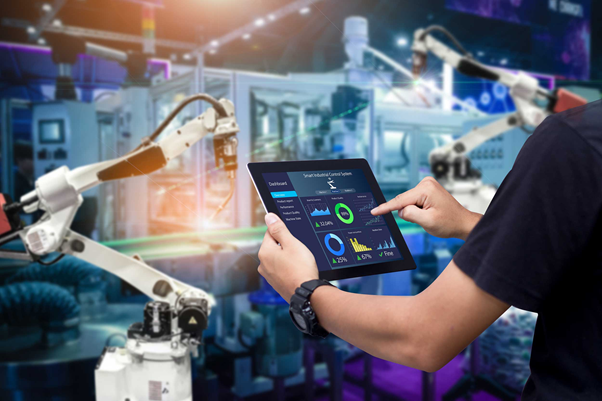After decades dominated by offshore manufacturing for the US market, a renewed focus on domestic manufacturing has taken hold. Headlines announce major factory investments and celebrate the return of production to US shores. This effort will not be sustainable if the focus is about simply bringing jobs back; it will require forging a new era of high-tech, globally competitive domestic production. Advancements in AI and powerful development platforms like Umajin are making this future more attainable than ever.
The call for increased domestic manufacturing stems from a variety of factors, including supply chain resilience, national security concerns, tariff policy, and the potential for economic growth and job creation. However, to compete effectively on a global scale, this new wave of American manufacturing needs to leverage the full potential of automation, robotics, and data-driven processes to achieve globally competitive levels of efficiency and quality. The future of manufacturing lies in highly skilled individuals working alongside intelligent machines, managing complex systems, and innovating new processes.
A fundamental shift enabled by AI in manufacturing is the move from reactive operations—fixing machines after they break, inspecting quality after production, responding to supply disruptions as they happen—to a proactive and predictive model. By anticipating failures, preventing defects before they occur, automating additional repetitive tasks, and forecasting demand more accurately, AI allows manufacturers to optimize resource utilization, maximize up time, and minimize waste in a way that fundamentally changes operational strategy and creates significant value.
The integration of advanced automation and AI into manufacturing inevitably raises questions about the future of work. Historical anxieties about technology rendering human labor obsolete resurface with each wave of innovation. However, the narrative of wholesale job elimination is overly simplistic. History suggests that while automation displaces certain jobs, it simultaneously transforms existing roles and creates entirely new ones. Increased productivity driven by automation can lower production costs and prices, stimulating consumer demand and leading to job growth in other sectors or in new roles supporting the automated systems themselves. The reality is often a complex shift in the types of jobs available, rather than a net destruction of employment.
Platforms like Umajin play a crucial role in accelerating the adoption of advanced manufacturing technologies by significantly shortening the time required to deploy supporting software. This includes faster rollout of interfaces for monitoring and controlling automated systems, custom dashboards for visualizing real-time production data, intuitive front-ends for interacting with complex digital twins, and bespoke workflow applications tailored to specific factory floor needs. In addition, the platform dramatically accelerates the development and deployment of the AR and VR training applications needed to upskill the workforce for these new environments.
Umajin’s framework allows for rapidly integrating native and third-party building blocks required for spatial front-line solutions. This includes the ability to build enterprise applications and workflows using 3D asset libraries and AI tools, easily incorporate the latest machine vision models, and manage an AI pipeline for data collection, training, testing, and deployment. This comprehensive approach is vital for creating the sophisticated systems needed for modern manufacturing and for training the workforce to utilize them effectively.
Umajin’s ability to efficiently stitch together AI and spatial applications means that manufacturers can quickly build solutions for tasks like automated industrial inspection, real-time IoT integration with digital twins for simulation and process control, and robotic integration. These are the building blocks of highly productive, automated factories.
Beyond enabling the technology, platforms like Umajin can also play a significant role in workforce development. The platform’s visual and chat-style interface can make it more accessible for a broader range of workers to interact with and even develop applications. This can help democratize access to the tools of advanced manufacturing and empower workers to participate in the digital transformation of their workplaces.
Making complex information more intuitive and understandable for less skilled workers is a key opportunity. Traditional manufacturing often relies on interpreting dense technical manuals or complex 2D blueprints. XR presents information visually, interactively, and contextually. Step-by-step AR guidance overlaid on a machine is far more intuitive than deciphering a schematic. This shift towards visual and experiential learning can be particularly beneficial for individuals with different learning styles or those who find abstract information challenging, potentially lowering the formal educational prerequisites for certain technical roles and widening the pool of potential candidates.
Interactive VR training is another area where platforms like Umajin, with its spatial capabilities and XR features, can make a significant impact. Training simulations in virtual environments can provide workers with hands-on experience with complex machinery and processes in a safe and controlled setting, accelerating the acquisition of high-level skills.
The objective of more domestic manufacturing in the US is driving a need for highly productive, automated facilities powered by a skilled workforce. AI and development platforms like Umajin are not just tools for building applications; they are enablers of this transformation. By accelerating the development and deployment of advanced manufacturing solutions and providing accessible ways to train and support workers, these technologies are paving the way for a new era of American manufacturing characterized by innovation, high-wage jobs, and global competitiveness.
